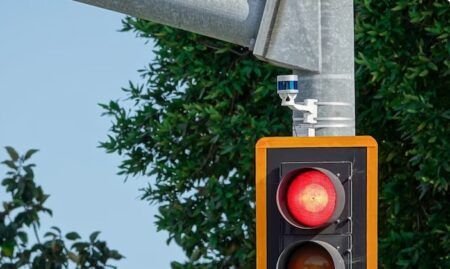Two divisions of Fujitsu, the Japanese information technology (IT) multinational, have announced the joint development of a technology that uses image processing and machine-learning to analyze surveillance camera images of traffic, with high accuracy and in real time, to recognize different roadway conditions, such as congestion and accidents, as well as violations.
The technology developed by Fujitsu Laboratories and Fujitsu Research and Development Center Co. adds a low cost and highly accurate functionality to existing camera systems, and achieves high-precision traffic-video analysis by combining two technologies. The first technology analyzes images from surveillance cameras installed along highways and streets, automatically grouping characteristics that can lead to recognition errors, such as changes in lighting and environmental factors, including night and fog, and images from cameras that have been similarly positioned. The second technology analyzes moving objects, such as vehicles and people, and efficiently identifies complex incidents such as accidents, while minimizing computational demands.
Analyzing complex events, such as traffic accidents, requires continuous monitoring of the combined motions of multiple related moving objects, which needs enormous computational power. The new technology quantifies a scene’s anomaly score based on changes in vehicle speeds and directions, and only when this number exceeds a certain amount does it analyze multiple nearby moving bodies, keeping computational load to a minimum.
In field trials of this technology conducted in cities around China in collaboration with the Tsingha University Suzhou Automobile Research Institute (TSARI), it was found that 11 types of incidents could be detected: traffic jams; anomalies, such as traffic accidents; driving in reserved emergency lane; illegal parking; wrong-way driving; vehicle on road; street occupancy; smoke; fog/haze; traffic-flow statistics summarization; and congestion index summarization.
In the field trials, the system achieved a recognition accuracy of 90-95%; an improvement of 5-10% compared with before the new technology was applied. With the newly developed software, by reducing computationally intensive image processing with proprietary high-speed algorithms, a single commercially available PC is able to take input from four surveillance cameras, and is able to simultaneously perform recognition processing on seven events from each camera. Even when used with existing cameras that do not have advanced image-correction features, the technology can be used to deliver a highly accurate, low-cost monitoring system that can automatically assess traffic conditions, apply traffic-flow controls and analysis to reduce congestion, and take quick action in response to accidents and traffic violations.
The Fujitsu teams are working to increase the accuracy and type of incidents recognizable with this technology, and plans to continue field trials jointly with TSARI. By combining this technology with Fujitsu’s SPATIOWL cloud service that uses location information, the companies aim to roll out a service in China next year that recognizes incidents occurring over a wide area in real time and instantly plot them on a map. Following that, they aim to extend to other regions, including Japan.




